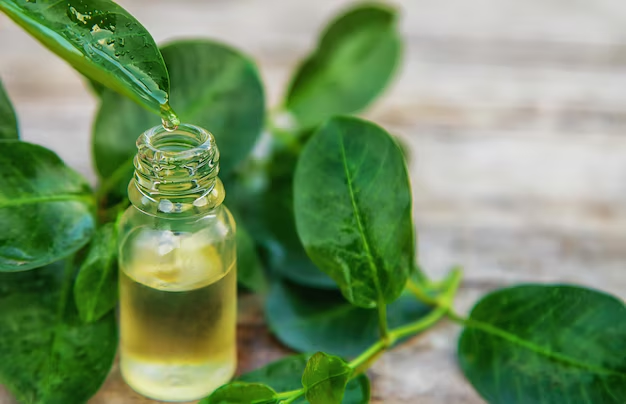
The skincare dilemma
It was night on the eve of Anna’s eagerly awaited job interview when she saw a red, angry pimple on her chin. “Not now!” she breathed, looking at the mirror. Like many of us, Anna had had some experience of acne, but this one had appeared at the worst possible time. Two well-tried products were in her bathroom cabinet: tea tree oil vs salicylic acid. Both had saved her before, but who would respond faster this time? She couldn’t decide which to use—and she knew she needed to make it stick.
For those of us who have fought the fight against acne, the decision between using tea tree oil and salicylic acid is a too-familiar conundrum. Both ingredients are hailed as acne-fighting heroes, yet each works differently. How do you choose which one to use? In this article, we will compare the pros and cons, and effectiveness of both salicylic acid and tea tree oil, so that you can better understand which is the right solution for your skin care needs.
The power of tea tree oil: Nature’s answer to acne
Tea tree oil, derived from the leaves of the Melaleuca alternifolia plant. Has been used by Australian aborigines for centuries because of its medicinal properties. Tea tree oil is now famous worldwide for its therapeutic use in the treatment of skin ailments, including acne. So, what makes tea tree oil so special?
The rise of organic extract oils in skincare
Tea tree oil is part of a broader trend towards the use of natural oils in skincare. As organic extract oils are in growing demand, people are looking for plant-based treatments for acne. The global market for essential oils like tea tree oil has been booming. The essential oil market was valued at USD 18.6 billion in 2021 and is predicted to reach a CAGR of 7.4% between 2022-2030, as per Grand View Research. This indicates the growing need for clean, organic beauty products among consumers.
Alongside this, there is also growing demand for the natural watermelon seed oil, used for treating skincare and other extraction oils, with the movement toward more organic forms of treatments. People desire the means of eliminating acne from the use of chemicals, and tea tree oil is the way forward.
How does tea tree oil fight acne?
- Antimicrobial activity: Tea tree oil is rich in terpinen-4-ol, a compound of essential oil with established bactericidal efficacy against Propionibacterium acnes (P. acnes), the microbes responsible for causing acne.
- A clinical trial by the Journal of Clinical Microbiology Reviews (2018) demonstrated that tea tree oil could inhibit acne-causing bacteria significantly and hence act as an effective antibacterial agent.
- Anti-inflammatory effects: Acne is often accompanied by redness and inflammation. Tea tree oil can reduce this inflammation, and therefore pimples will appear less severe.
- Mild and natural: Compared to some chemical-acne products, tea tree oil is considered a more natural and gentle alternative. Many people who are drawn to the rise of organic extract oils in skincare prefer using essential oils like tea tree oil due to their perceived safety and gentleness on the skin.
Salicylic acid: The BHA you can count on
While tea tree oil is touted for its natural healing qualities, salicylic acid is the tried and true acne treatment hero of the old faithful variety. Salicylic acid is a beta-hydroxy acid (BHA) that is derived from willow bark and has been used in acne treatment for years. Salicylic acid peels the skin and penetrates deep into pores to cleanse of oil, dirt, and dead skin cells.
How salicylic acid works
- Exfoliation power: One of the strengths of salicylic acid is that it exfoliates the skin. It breaks down the adhesive holding dead skin cells together, peeling them off the skin’s surface and opening up pores.
- Deep pore penetration: Unlike tea tree oil, which stays on the surface of the skin, salicylic acid penetrates deep into pores. That’s why it is so effective at eliminating blackheads and whiteheads, which are the result of a clog in pores.
- Anti-inflammatory properties: Just like tea tree oil, salicylic acid has anti-inflammatory properties. It can reduce redness and swelling, making it ideal for calming inflamed acne.
Pros and cons of salicylic acid for acne
- Fast effects: Because of its ability to penetrate deep into the skin and exfoliate, salicylic acid has a faster effect compared to tea tree oil. Many people say they notice differences within days of using it.
- Drying potential: Salicylic acid is potentially drying, especially for people with dry or sensitive skin. Follow up with a moisturizer after follow up to avoid irritation.
- Too strong for sensitive skin: Salicylic acid may be too harsh for people with sensitive skin, and overuse may lead to redness or peeling.
Comparing tea tree oil and salicylic acid for acne treatment
Now that we’ve explored the benefits of both tea tree oil and salicylic acid, how do they compare head-to-head? Let’s break down their effectiveness in different scenarios:
Tea tree oil vs Salicylic acid for oily skin
If you have oily skin, both salicylic acid and tea tree oil can be applied to regulate oil secretion. Salicylic acid is generally more efficient in purifying pores and preventing excess oil buildup. Since it has the ability to penetrate deep. However, tea tree oil is also a good option for oily skin if you do not want to use something synthetic.
Moreover, the majority of skin care hobbyists are also finding the benefits of watermelon seed oil in skin care as a lightweight oil for oily skin, driving the trend towards natural oil-based treatments.
Tea tree oil vs Salicylic acid for sensitive skin
Individuals with sensitive skin might find themselves drawn to tea tree oil due to its less irritating character. Salicylic acid sometimes results in dryness or irritation, especially among those who have not used chemical exfoliants before. Tea tree oil, particularly when combined with a carrier oil, has fewer chances of irritating the skin.
Real-world results: What the research says
Tea tree oil for acne: What studies reveal
Tea tree oil has been the subject of numerous studies. Some of which support its efficacy in the treatment of mild to moderate acne. A 2017 clinical trial in the Australian Journal of Dermatology determined that the participants who applied a 5% tea tree oil gel had a 43%. Reduction in acne lesions after merely 12 weeks of treatment. This research points to tea tree oil as a natural acne treatment, although the effects may be delayed.
Salicylic acid for acne: What the data shows
Salicylic acid, however, is a gold standard proven over time for the control of acne. In one study in Dermatologic Therapy published in 2020, application of 2% salicylic acid cleansers reduced non-inflammatory acne (blackheads, whiteheads) by 60% within an 8-week time period. That instant work at getting pores clear and preventing future activity is putting salicylic acid solidly in the must-try category for those with acne.
Conclusion: Which is the better acne treatment?
In the war between salicylic acid and tea tree oil, the decision is really up to your skin type, acne issues, and chemical/natural treatment.
- Tea tree oil is a good option for people looking for a natural, botanical solution for mild or moderate acne, especially if they have sensitive skin.
- Salicylic acid remains among the finest therapies for blackheads, whiteheads, and oily skin with stronger penetrative cleansing action and faster response.
Whether you’re utilizing the natural potency of extract oils such as tea tree oil or the peeling action of salicylic acid, you must be consistent. Both are excellent in their own way if you apply them correctly.
So, have you selected the perfect treatment for acne for yourself? Will you be going the natural way with tea tree oil, or the safe way with the tested solution of salicylic acid?




